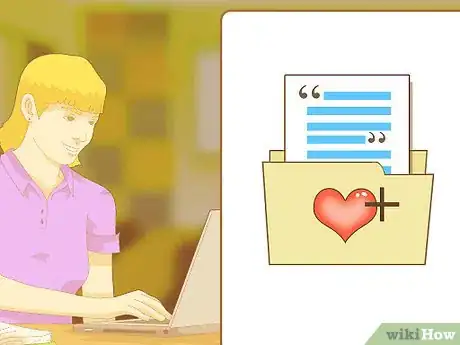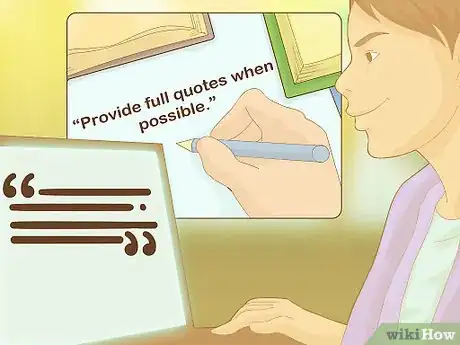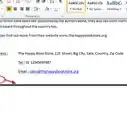This article was co-authored by Linda Chau. Linda Chau is a Public Relations Specialist and the CEO and Founder of PAAPR Agency (Public Attention And Public Relations). With over a decade of experience, she specializes in strategic planning, brand storytelling, press communication, and reputation management. Linda holds a BA from The University of California, Riverside and has been featured in AdAge, Austin Business Journal, and more.
This article has been viewed 62,240 times.
In a given week, it is not uncommon for editors, journalists, and radio and TV reporters to receive hundreds of press releases. For a press release to grab the attention of the person making the decisions about what is printed or broadcast, it has to stand out. A good publicist uses quotes to draw the attention of journalists and media figures. A journalist, on the other hand, will use press releases as a jump-off point into the story they're covering.
Steps
Choosing a Quote In a Press Release as a Publicist
-
1Place a quote in your press release that shows the positive impact your subject matter will have on readers or viewers. For example, if you are writing about a new company opening, the quote should be about what the company will bring to the area in which it will be located.[1] Quote a company spokesperson or corporate head about sustainability, new jobs, the company's commitments to protecting the environment, and being a good community partner.
- If your press release is announcing a performer who is making an appearance in your community, get a quote from the performer about something he or she has done for charity. Be sure to ask the person how the gesture made him feel, as this will give the reader a glimpse of the performer's good character.
- For instance, if a renowned singer was coming to play a concert in your city, she might be recognized not only as an award-winning artist, but as a philanthropist who has donated money to a local nonprofit which offers free music lessons to kids. A quote like “It's important that everyone be empowered to follow their dreams just like I was by teachers who believed in me,” will show she is not just interested in making money, but promoting positive change in the community.
- Use quotes to address any problems that might be solved or alleviated by the subject of your press release. For instance, if you are writing about a new store, find a quote that illustrates how the shop will boost the economy, give shoppers more choices, or add to the ambiance of the place in which it is opening. Quote an industry leader who supports the new store's opening. “I expect the new store to add 400 jobs and $100,000 to the local economy in the first quarter of the year alone,” is a perfect quote to show the benefits of the new store. If you're promoting an event, use a quote that details the family fun or affordability aspects of the event.
-
2Use quotes as a call to action. Including a quote in a press release can inspire readers or journalists to follow up with a desired behavior.[2] If the press release is about a rock band's tour, for instance, you could use a quote from fans who have seen the band to declare the tour a great success and encourage other people to attend their concerts. “This band sounded amazing, everyone who listens to them needs to see them live!” is a rave review, likely to move readers to catch the band on tour. If the press release is about an author's new publication, you could quote reviewers who reviewed it favorably to lead into a sales pitch about where the book is sold.Advertisement
-
3Use the quote to personalize the event or story. Quotes should illustrate why the story matters on a human level. What people say, think, and feel can be expressed in a powerful quote. A solid quote can break through the humdrum of a press release loaded with facts and statistics. Use quotes to demonstrate the real world effects the press release describes.[3]
- For instance, when reporting that your celebrity client donated a cool million to the Children's Cancer Research Center, you might draw attention to the fact that over 10,000 children per year are diagnosed with cancer in the US alone. But quoting a child who was able to access treatment at the center will underscore the importance of your client's donation. Something heartwarming like “I'm so happy the doctors here are giving me a chance to live again.”
- While the bulk of your text will relate hard data, quotes from actual people will help put a face on whatever it is you are writing about.
-
4Avoid quotes loaded with jargon.[4] Unless you're issuing a press release to an industry trade publication or industry insider website, avoid selecting quotes which won't be understood by popular audiences. The more accessible you make your subject, the more interest you will generate.
- For instance, “The double-quark boson hydrosphere will eliminate the need for conventional synthetic external H2O protective gear and increases the likelihood that saturation will not occur” is a cumbersome quote and includes words which the average reader cannot define. By contrast, a company leader who explains “Our new rain poncho's molecular technology makes it the best on the market” is far more easily understood by the average reader and journalist.
-
5Translate your quotes carefully. Unless you're fluent in the languages you're translating, you'll need a translator (or better yet, two) to ensure the quotes are translated into the target language appropriately. Be sure the quotes match the tone as well as the meaning of the original quote. Get the text double-checked by another translator. Clear up any points of disagreement before publishing.
- When you quote the translated individual, indicate they were speaking originally in another language. For instance, “Speaking through a translator, Mr. Di'Marco reported 'Third quarter profits are expected to rise by twenty percent.'”
Using a Quote Properly as a Publicist
-
1Avoid fragmentary quotes. Generally, a quote should represent what someone said, not a part of what someone said. If a journalist or media outlet decides the full quote is unnecessary or too cumbersome, that's their call. When issuing a good press release, however, it's always best to provide the full quote.
- For instance, a market analyst might decide that a company's stock is “Worth investing in, assuming its profits next quarter continue to rise.” Releasing a press release which quotes the analyst as saying only the stock is “Worth investing in” is a misrepresentation of the analyst's actual comments. You might no even do this deliberately. Often, you might fail to include the last bit for brevity or because you're excited to report good news about a client. Failure to provide a full quote could lead to the deterioration of the relationship between you and the journalists who you distribute press releases to, as well as between you and the analyst whose words you quoted only partially.
-
2Don't introduce quotes up front. Unless you have a truly exceptional and memorable quote, you should wait to introduce quotes until after the basic purpose of the press release has been laid out. The third paragraph is a good point at which to begin bringing in quotes. Introducing quotes up front means that the quotes are being used without any real context in which to understand them, which leads readers to confusion or misunderstanding.
-
3Get permission from quoted individuals to use their statements. You may take some creative license when crafting a quote on behalf of the individual you're representing, but before putting it in print, run it by them to ensure they're comfortable with “your” statement. If you're quoting an industry wonk or talking head, it's best to represent what they said verbatim, but you'll want to run it by them before publication anyways.
-
4Give credit in your quotes. Avoid attributing quotes to “A Satisfied Customer” or some equally vague entity. Similarly, don't attribute quotes to a company; get a quote from an employee or project leader to give your press release more personality. Use full names to ensure the quote is attributed correctly.
- When attributing quotes, stick with the verb “said.” Other speech-related verbs are loaded with some positive or negative connotation.[5] “CEO Harvey Mitner said 'The Oxy-jet 9000 is the best window squeegee on the market'” is one example of how to credit someone effectively using “said.”
- Place the attribution at the end of the first sentence. If the source has more to say, have his or her quote continue in the next few sentences. For example, you might write, “'Our new burger will blow away the competition,' head chef Hal Mavner said. 'There's no other burger with a flavor profile like it.'”
- If you quote the same source again later, just refer to them by their surname.
-
5Don't overdo it. Limit the number of quotes you use per press release. Use them sparingly to avoid boring readers. A good press release will use quotes to spice up the bulk of their analytical or descriptive text. Quotes should typically be no more than three sentences.[6]
Using Quotes In a Press Release as a Journalist
-
1Adjust the press release to match your publication standards. Do not use nonstandard spellings in your quotes. There are some occasions where you can utilize abbreviations which conform to a journalistic writing style, such as Sen. for Senator, $3 instead of three dollars, and St. Instead of Street.
-
2Provide full quotes when possible. If the full quote is direct and concise enough, use it. It's always best to avoid substituting your own words for those of someone else. Let the press release speak for itself (or rather, for the person on whose behalf it was released).
-
3Report the context of the quote fairly and accurately. Make it clear when reporting why and how the press release was issued, and what the exact policy, commitment, or statement refers to. A press release announcing a candidate for political office is leaving the race might be framed alternately as either a response to a corruption scandal, or in response to health problems. It is the task of the journalist to accurately represent or reasonably speculate upon the event(s) which precipitated the press release.
-
4Use pull-out quotes to emphasize a point. Pull-out quotes are those which, when the article is printed, are enlarged in a sidebar or adjacent text box to attract readers' attention and really hammer home someone's perspective. Pull-out quotes are also sometimes used onscreen in TV reporting, where they serve the same function.[7]
-
5Translate the quote accurately. Ensure your translation is faithful to the tone and meaning of the original quote. If possible, get the original transcript translated twice by two different translators and check for discrepancies. If any exist, try to clear them up or find another more direct quote. Note the original language of the press release in the article.
References
- ↑ Linda Chau. Public Relations Specialist. Expert Interview. 19 May 2021.
- ↑ https://books.google.com/books?id=KNU1KOoeWkgC&lpg=PP1&dq=Press%20Release&pg=PA59#v=onepage&q&f=false
- ↑ https://books.google.com/books?id=L674_Gj39aYC&lpg=PA56&dq=How%20to%20Use%20Quotes%20in%20a%20Press%20Release&pg=PA104#v=onepage&q&f=false
- ↑ https://books.google.com/books?id=XN_d2Cf7vT4C&lpg=PP1&dq=How%20to%20Use%20Quotes%20in%20a%20Press%20Release&pg=PA114#v=onepage&q&f=false
- ↑ http://www.hypergridbusiness.com/2012/06/10-steps-to-a-good-press-release-plus-one-bonus-step-for-a-great-one/
- ↑ http://www.hypergridbusiness.com/2012/06/10-steps-to-a-good-press-release-plus-one-bonus-step-for-a-great-one/
- ↑ https://books.google.com/books?id=L674_Gj39aYC&lpg=PA56&dq=How%20to%20Use%20Quotes%20in%20a%20Press%20Release&pg=PA104#v=onepage&q&f=false










































































